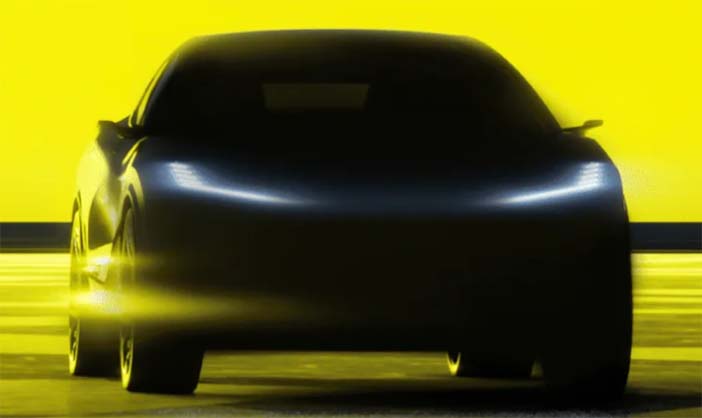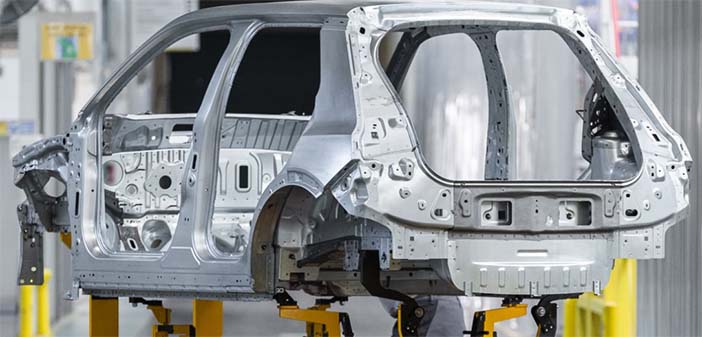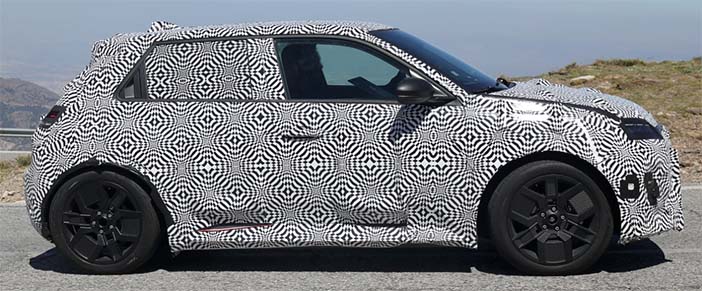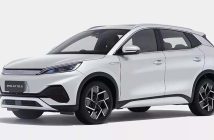+++ E-commerce giant AMAZON said Thursday it would start selling new automobiles on its platform in the United States next year. Amazon made the announcement at the Los Angeles Auto Show in conjunction with Hyundai, the South Korean auto giant that will be the first brand sold on the site. The company said customers will be able to choose models and their favorite features online. They can then pick up the car at their local dealership or have it delivered to their home. Financing options will also be available on Amazon. “Hyundai is a very innovative company that shares Amazon’s passion for trying to make customers’ lives better and easier every day”, said Amazon Chief Executive Andy Jassy in a statement. Until now, car buyers could browse offerings on Amazon, but could not make their final purchase on the site. The partnership with Hyundai will also see Amazon’s Alexa smart speaker featured in models starting in 2025. Even though Amazon’s plan includes the cooperation of dealers, direct-to-customer sales have expanded in recent years, led by Tesla and other electric vehicle companies that do away with the traditional dealership middleman. Car makers like Ford are trying to use the release of EVs to loosen their dependence on dealerships that end up making a vehicle more expensive. U.S. companies that sell used cars online saw their share price plummet on Amazon’s news. Shares of auto retailers CarMax and Carvana dove more than 5 percent. +++
+++ Battery maker LG Energy Solution and U.S. automaker Ford have scrapped plans to build a joint battery plant in Turkey that they announced 9 months ago. The 2 companies were expected to invest a combined 3 trillion won to build the plant, but they canceled the plan after Ford announced in recent weeks that it is postponing $12 billion in planned investment in ELECTRIC VEHICLES due to slowing demand. Their Turkish partner Koc Holdings announced last Saturday that a memorandum of understanding signed with LGES and Ford in February of this year has been annulled. The 3 companies had hoped to build a 25 GWh automotive battery plant for EVs to be sold in Europe by 2026 and expand output to 45 GWh in the future. Although the MOU was non-binding, it is rare to see a deal of that scale get scrapped in just 9 months. LGES, whose cumulative orders have surpassed 500 trillion won, has been expanding plants either already operating or being built in Indonesia, Poland and the U.S. as well as South Korea. When it announced the joint project last February, it pledged to “take the lead” in the European EV market. But the outlook has shifted. LG said in a statement, “We mutually agree that this is not the appropriate time to continue with the investment in a battery cell plant in Turkey considering the current pace of EV adoption”. SK On and Ford also recently said they could postpone plans for a second EV battery plant in Kentucky, which was expected to begin operations in 2026, while the Volkswagen Group announced early this month that it will indefinitely postpone a fourth EV battery plant it had been eying in Eastern Europe. The slowdown in Europe’s EV market is the biggest cause of the delays. According to the International Energy Agency, the EV market in the EU grew 40 percent annually on average from 2017 to 2019, but growth slowed to 15 percent last year. Volkswagen also said EV orders in Europe fell from 300.000 cars in 2022 to 150.000 this year. But EV battery makers are merely still cautiously optimistic. Although the Turkish plant has been canceled, LGES will still supply Ford with EV batteries from its existing factories
“Although supply volume could shrink due to slowed demand, profitability could increase if EV batteries are manufactured at a proprietary plant instead of a joint factory”, an industry insider said. SK On said early this month that its battery plant schedule will not be hugely affected by the pace adjustments of automakers. It said its plants in Tennessee and Kentucky will start operations in 2025 as scheduled, and no supply bottlenecks are expected. +++
+++ The HYUNDAI MOTOR GROUP stands as the second-largest player in the U.S. market for electric vehicles (EVs) despite concerns surrounding Washington’s protectionism policy, data showed. Hyundai took up 4.8 percent of the American EV market in the January-September period, with its smaller co-affiliate Kia accounting for 2.7 percent. Their combined market share came to 7.5 percent, or 64.000 vehicles, taking up the second-largest slice of the U.S. EV market following Tesla, which posted a 57.4 percent share, or 489.000 vehicles. General Motors’ Chevrolet brand accounted for 5.9 percent, followed by Ford with 5.5 percent. In the first 9 months, overall EV registrations in the U.S. jumped 61 percent year-on-year to 852.904, the data said. It is expected that EV registrations in the world’s most important car market will exceed 1 million for the first time this year if EV sales continue to rise despite the slowing pace of growth. Hyundai’s latest performance came amid the U.S. Inflation Reduction Act (IRA), which provides tax credits of up to $7.500 to purchasers of electric vehicles that are assembled in North America. Currently, all Hyundai and Kia EVs sold in the North American market are manufactured in South Korea, making them ineligible to receive the credits. Nevertheless, their products can qualify for the support when used for commercial purposes, such as leasing. +++
+++ In JAPAN , Toyota, Honda and Nissan all raised their operating profit forecasts for the current fiscal year on the back of strong sales, in what can be seen as a validation of their view that the shift to fully electric vehicles will take longer and require more patience by the industry. General Motors and Ford learned that the hard way. They were forced to pull guidance recently following weeks of strikes by the United Auto Workers over wage hikes and job security in the EV future. They also scaled back aggressive electrification plans. “You go too fast, you crash,” said Christopher Richter, senior analyst at CLSA Securities Japan. “Ignoring the external pressures and getting it right is more important than doing it fast. The Japanese makers seem to appreciate that there would be bumps on the road to electrification”. +++
+++ LOTUS is a totally different brand to the low-volume sports car manufacturer it was just a few years ago. It’s been working hard to appeal to traditional luxury car buyers and corporate executives with its first 2 ‘lifestyle’ EVs: the Eletre SUV and recently unveiled Emeya hyper-GT. Next, the brand is hoping to broaden its appeal once again with the introduction of a new mid-size electric SUV that’ll take on the Porsche Macan EV and BMW iX3 when it goes on sale in 2026. We’ve known a model like this was headed our way for some time, as it was part of Lotus’ plans to launch 4 EVs by 2026. The first 2 were the Eletre and Emeya, followed by this as-yet-unnamed ‘D-segment SUV’, then a fully-electric sports car that’ll serve as a replacement for the petrol-powered Emira. The car’s official name remains a closely guarded secret for now, and won’t be announced until much closer to a world debut that’ll take place in late 2024, but it’s being referred to internally as the Type 134. Lotus has only released one shadowy image of its first mid-size SUV and that reveals little except for the car’s unique headlight design. Lotus’ VP of design, Ben Payne, was on hand at the debut of the Emeya to provide me with some exclusive insights into the looks of the brand’s first-ever mid-size SUV: “the SUV D-segment is so large. That, in a way, makes the Type 134 one of the most difficult products we will do. To really penetrate that segment and achieve high volume, which is what it’s all about, we’re going to have to make a product that’s as broad in its appeal as possible. “I imagine something that’s probably a little bit more pure in its expression. And we’ve got to balance usability, practicality and performance in that car, but we’ve got to make something unique that stands out. So you’ll see a continuation of this language and this DNA, but the expression of it being evolved and possibly simplified a little”. He also explained; “we don’t want a cookie cutter approach. We’re going to evolve things and we’ll react to customer feedback, and we’ll react to the perception and changing market trends which evolve very, very quickly now, and we will push this design language forward. But there will be common threads that carry through the designs of the products”. As such, I expect the Type 134 will feature a similar nose design to the Eletre, Emeya and Emira, which despite their vastly different sizes and purposes, do share some resemblance from the front. The active front grille from the Eletre and Emeya is also likely to be carried over, with the petals opening to help cool the battery and motors underneath, or remaining closed to help improve aerodynamic efficiency. I expect there’ll be other aerodynamic aides at the rear, along with a full-length light bar like those one on its larger siblings. The Type 134 will play a crucial role in Lotus achieving its goal of producing 150.000 cars a year by 2028, with the brand’s vice president and chief commercial officer, Mike Johnstone, telling: “We see the Type 134 as a real catalyst for the second phase of growth for us”. The brand is already posting impressive sales results though, taking more orders in September 2023 than Lotus would typically take over a calendar year, and seeing a 43 percent increase on the previous month’s results in October. +++

+++ In the 19 years that Autointernationaal.nl has been in existence, scarcely a day can have gone by without the team here talking about, or publishing a story on, Ford and Opel. From Fiesta to Corsa, Escort and Focus to Astra, even Capri to Calibra, these classic brands have been arm-wrestling over the MIDDLE GROUND of the Dutch car market for generations. They were behemoths in the Netherlands long before this website hit the internet, in fact, and they still clash at the sharp end of a number of market segments that are key to mainstream customers. Will that continue to be the case, say, 10 years from now? It’s less certain. We’ve already seen the companies taking different courses, with Ford notably abandoning the B-segment and the Focus is set to disappear in 2025, handing that bit of the family-car war on a plate to the Astra. Equally, Opel brand doesn’t have a direct rival for the Mustang Mach-E. But in truth, what’s likely to guide the fortunes of these 2 famous names is the ever-increasing onslaught from Hyundai and Kia (both originally value-focused brands, now knocking on the door of premium customers) and the Chinese newcomers. The 2035 deadline for petrol and diesel new-car sales means that there’s a race to become established as suppliers of affordable, efficient, properly specced EVs; just as Ford and Opel have dominated much of the accessible market up to now. And it could well get messy. It would be a tad harsh to say that these 2 classic names have been caught napping, but buyers are still deciding what, in this fast-developing era, constitutes an acceptable price for an acceptable amount of technology. Given that this is the principle that has guided Ford and Opel, the 2 brands must want it to be settled sooner rather than later, so they can get on with delivering it. +++
+++ We’ve been waiting with bated breath for the reveal of the road-going RENAULT 5 since the original heartwarming concept was unveiled at the beginning of 2021, but we won’t have to wait much longer as the production-ready model will be taking center stage at the 2024 Geneva Motor Show next February. Sales are expected to begin not long after. At the unveiling of the 5’s even cheaper zero-emissions city car cousin, the reborn Twingo, the firm’s CEO Luca de Meo announced the reborn Renault 5 will start from €25,000 in Europe, where incentives for EVs are still available. Without them, the all-electric Renault 5 is likely to start from closer to €27.000 in the Netherlands. Nevertheless, it’ll still be among the cheapest electric cars on sale and undercut its most direct rivals like the new Mini Cooper and Peugeot e-208. The reborn Renault 5 represents a new era for the brand as Renault taps into its vast heritage to create what it hopes will become a future classic. In the path to production, all manufacturers go through multiple phases of prototyping, and now Renault has given us a glimpse of the process, showing off final validation prototypes of its new all-electric baby. Built within Renault’s Paris-based Prototype Build Centre, these new test cars will be shipped all around the world to complete final testing in all sorts of conditions to ensure the product that goes on sale to customers next year is as ship-shape as possible. What it also does, though, is give us our clearest indication yet of what to expect when the production model is revealed in a few months time.

Renault has indeed kept the production model very close to the R5 Concept it revealed at the beginning of 2021. We can clearly see that it will share the concept’s chunky proportions and compact 5-door body, with only subtle changes on the path towards production, such as the use of traditional front-door handles, standard wing mirrors and smaller wheels. The new 5 will be the first vehicle based on the Renault-Nissan Alliance’s CMF-B EV platform, which has been specifically designed for smaller electric vehicles. This platform will also be used by the new Renault 4Ever, a retro-inspired compact SUV, along with the new Nissan Micra. The brand is claiming up to 400 km of range for the R5’s larger 52 kWh battery pack, which will also likely come with a higher starting price. However Renault’s executive vice president for engineering, Gilles Le Borgne, confirmed to us that the entry-level model will be fitted with a 40 kWh battery, which will offer a more moderate maximum range but will also be more affordable. Charging is likely to be similar to that of the Megane E-Tech, which offers up to 130 kW rapid-charging speeds. This should allow up to 200 km of range to be added in around 30 minutes. The new 5 will be the first all-electric Renault to feature vehicle-to-grid (V2G) compatibility, which will be able to intelligently feed electricity back into your home when electricity tariffs are high, or even into the grid itself if demand requires it. There’s no negative effect on battery life according to Renault, with the service being available through a home-installed Wallbox terminal designed by Mobilize and accompanied by a special electricity contract. The V2G system will be available in 2024 in France and Germany, before arriving in the Netherlands in 2025. +++

+++ Several TESLA shareholders rebuked CEO Elon Musk for endorsing antisemitic views on his social media platform X, with some saying he should be suspended. “While I believe in free speech, there’s no excuse for the spreading of hatred by any CEO of any publicly traded company”, said Jerry Braakman, chief investment officer at First American Trust, which held about 16.000 Tesla shares as of September 30. “Tesla’s board should place him on leave for a month or 2”. The backlash against Musk is spreading. The White House condemned his actions as an “unacceptable” act that endangers Jewish communities. The administration said Musk’s posts were especially harmful, given the spike in antisemitic incidents following Hamas’ October 7 killing of 1.200 Israelis and Israel’s ensuing invasion of the Gaza Strip. Companies including Lions Gate Entertainment have suspended all advertising on the platform formerly known as Twitter. +++
+++ The next generation of the TOYOTACAMRY , the best-selling sedan in the U.S. market, will come with only a gas-electric hybrid powertrain, the boldest move yet by the Japanese automaker to push hybrid technology into the heart of the U.S. market. The 2025 Camry will combine a 2.5-liter gasoline engine with an electric drive system tuned to deliver more power in both front-wheel drive and all-wheel drive versions of the car, Toyota said. Compliance with tougher U.S. fuel economy rules was a factor in Toyota’s decision to make the new Camry an all-hybrid vehicle line, dropping 4- and 6-cylinder combustion models that made up about 85% of sales in the current model year, David Christ, head of the Toyota brand in North America, told. Another factor behind the decision was “the performance we were able to get out of the hybrid”, he said. While Toyota has accelerated development of electric-vehicle technology, it is still betting that demand for hybrids and plug-in hybrids will remain robust as the automaker takes a “multi-pathway” approach seeking to satisfy customer needs in every market. The hybrid powertrain and a new electronic all-wheel drive system deliver 232 combined horsepower; nearly 15% more than the outgoing Camry with a mechanical all-wheel drive system, Toyota said. Toyota executives unveiled the 9th generation of the midsized Camry sedan on Tuesday in Los Angeles, ahead of the Los Angeles Auto Show that opens on Friday. The new Camry will compete in a segment largely abandoned by the Detroit brands, with the exception of General Motors’ Chevrolet Malibu. The new Camry’s direct competitors (putting aside scores of compact and midsized SUVs ) will include a few remaining sedans such as the Honda Accord, the Hyundai Sonata and Tesla’s all-electric Model 3. The Tesla Model 3 outsold the Camry in California, a key market for Toyota, during the first 9 months of 2023, according to data from the California New Car Dealers Association. Toyota did not disclose pricing or fuel-efficiency figures for the 2025 Camry, due in showrooms next spring. The cheapest Camry hybrid model currently sells for about $2.400 more than the most inexpensive combustion Camry. Most of the hybrid powertrains sell at a $1.500 to $2.000 premium to combustion models, Christ said. “We think the value the hybrid powertrain brings is worth that kind of premium”. A current Camry hybrid is rated at 52 miles per gallon in combined city and highway driving, compared with a 32-mpg rating for the conventional 4-cylinder Camry. The hybrid saves $650 a year in fuel costs compared with the combustion model, according to U.S. government fuel economy data. Toyota previously switched its Sienna minivan to an all-hybrid powertrain approach. The Sienna is “our second-fastest turning car and the car we have the most reservations for”, Christ said. +++
+++ In the UNITED STATES , Hyundai has joined Honda and Toyota in raising factory worker wages after the United Auto Workers union reached new contract agreements with Detroit automakers. Hyundai said it will raise factory worker pay 25% by 2028, matching the general wage increase won by the UAW during that period. Toyota raised factory pay 9% to 10% starting in January, while Honda said it will increase wages 11% during the same period. Labor experts say the increases are at least in part aimed at thwarting UAW President Shawn Fain’s strategy of trying to organize U.S. auto plants run by foreign automakers and Tesla in order to increase the union’s bargaining power. Fain said terrified auto executives at nonunion plants are raising wages, and he called Toyota’s pay increase the UAW bump. “UAW, that stands for ‘You Are Welcome’ ”, he said. About 146.000 UAW members are voting on new contracts with General Motors, Ford and Stellantis that give them 25% general wage increases over the next 4 years and 8 months. When cost of living wages are factored in, workers will get about 33% raises, with the top assembly line employee making about $42 per hour. Toyota and Honda also accelerated the time it takes for a starting employee to reach the top pay rate, also matching or coming close to the time period in the new UAW contracts. Harry Katz, a professor of collective bargaining at Cornell University, said it’s likely the UAW settlement contributed to the raises at the nonunion factories. “There’s also a strong labor market, the companies are doing very well”, Katz said. “They’ve always wanted to stay nonunion, and they try to stay close to the Detroit top-tier wages”. In announcing its factory pay increases, Hyundai wouldn’t say how much the hourly wage is at its factory in Montgomery, Alabama, or how much it will pay at an electric vehicle factory under construction near Savannah, Georgia. By early next year the company said it will have increased factory worker pay 14% in the past year. Katz estimated that Hyundai now pays around $25 per hour, and he says the nonunion plants’ retirement, health care and other benefits are typically not as good of as what UAW workers get. “Hyundai continuously strives to maintain competitive wages and benefits commensurate to industry peers”, Jose Munoz, Hyundai’s chief operating officer, said in a statement. With its increases, Toyota’s top factory worker pay will go to $34.80 per hour in January. Honda wouldn’t say what its hourly rate will be, but analysts say it likely is comparable to Toyota’s. Katz said the UAW’s new contract probably won’t help the union get workers at the nonunion plants to join. The plants, he said, are in areas of the country that are often suspicious of unions. “Detroit’s wage has been higher than the nonunion before”, he said. “There’s always been a difference and they just haven’t been able to organize them. It doesn’t hurt them to have won such a large deal, but I don’t think it’s going to make that big of a difference”. +++


